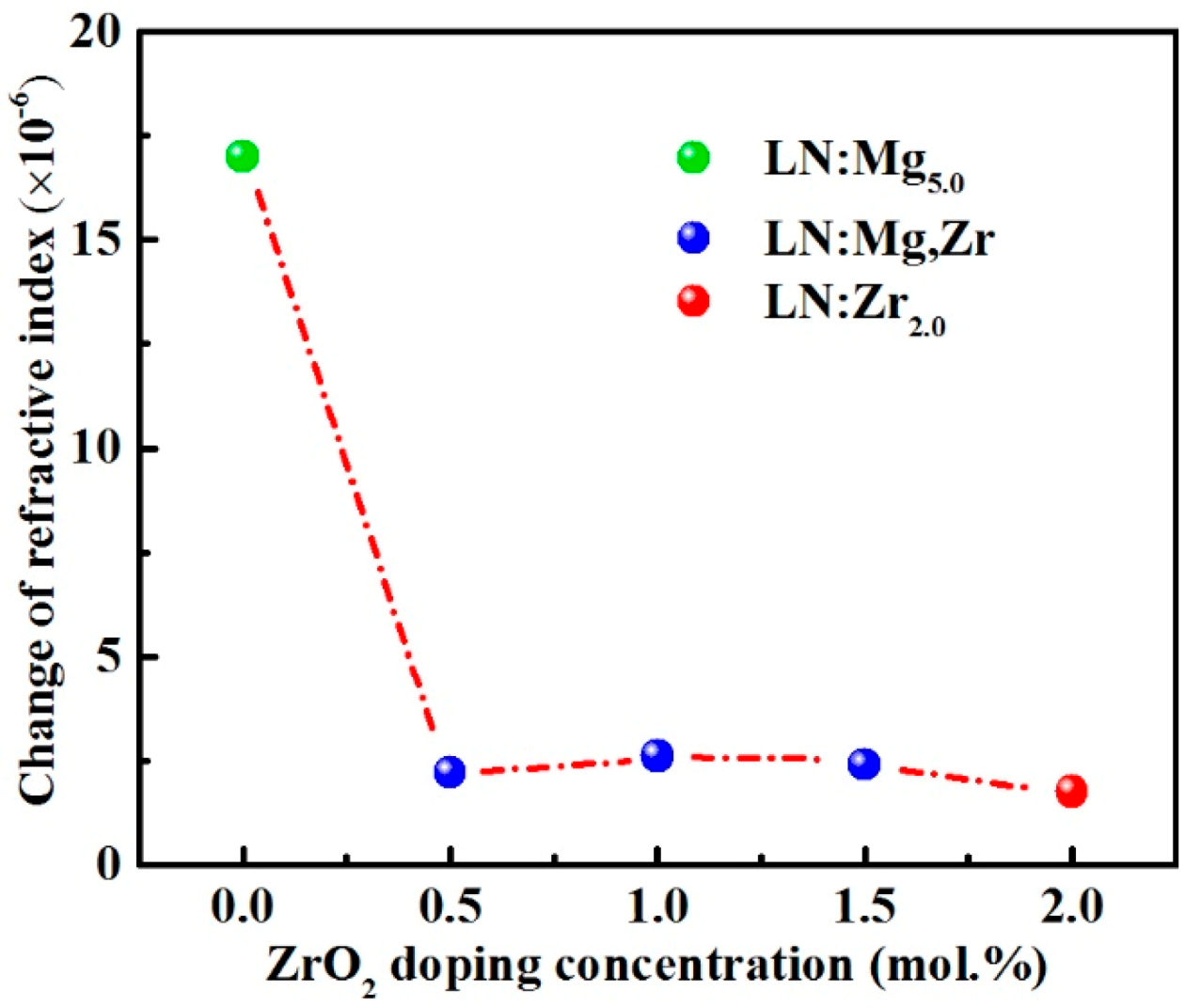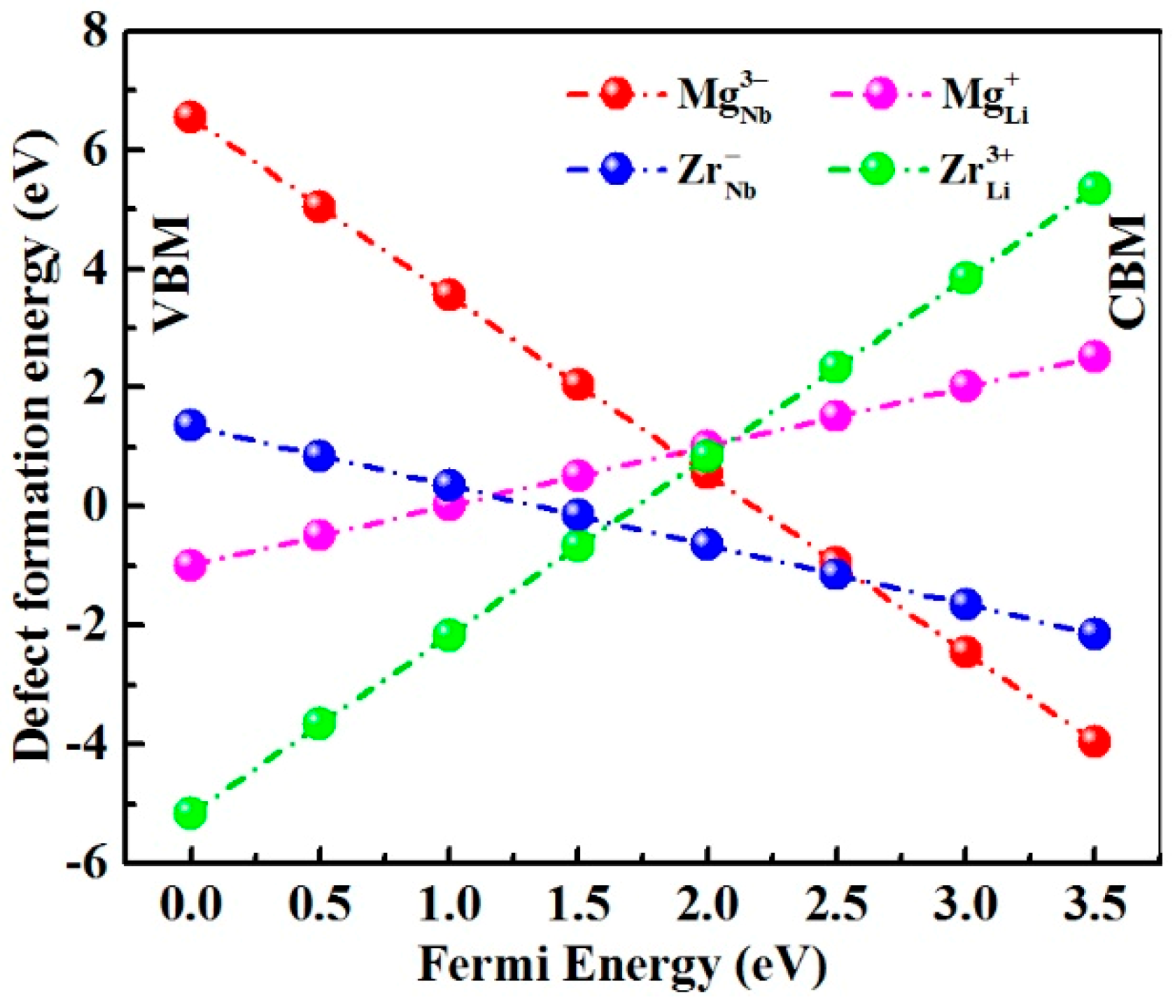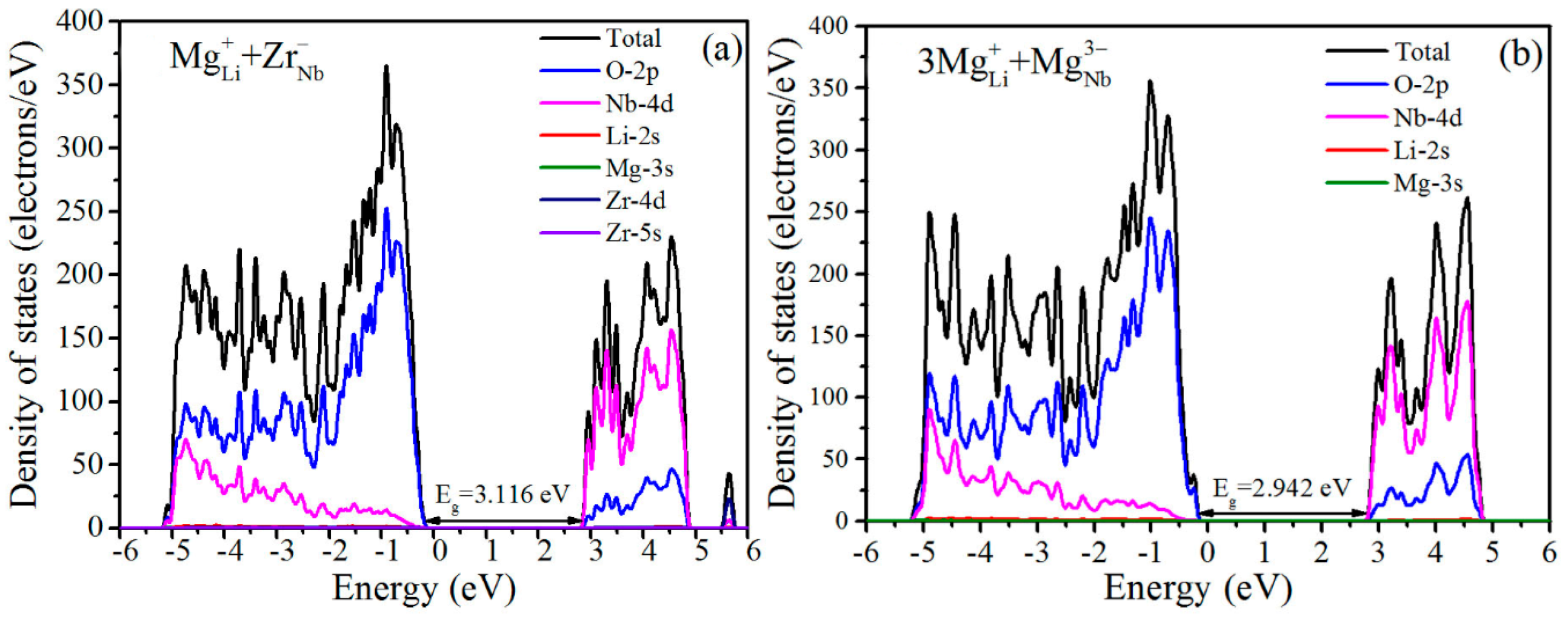Enhanced Ultraviolet Damage Resistance in Magnesium Doped Lithium Niobate Crystals through Zirconium Co-Doping
Abstract
1. Introduction
2. Materials and Methods
3. Results and Discussion
3.1. Resistance Against Ultraviolet Damage
3.2. Defects Structure in the LN:Mg,Zr
- Zr4+ and Mg2+ ions only occupy Li-sites, labelled as + + ;
- Zr4+ and Mg2+ ions replace Nb- and Li-sites, respectively, labelled as + ;
- Zr4+ ions only substitute Nb-sites while Mg2+ ions occupy both Li- and Nb-sites, labelled as + + .
3.3. Charge States of LN:Mg,Zr
4. Conclusions
Author Contributions
Funding
Institutional Review Board Statement
Informed Consent Statement
Data Availability Statement
Conflicts of Interest
References
- Carrascosa, M.; García-Cabañes, A.; Jubera, M.; Ramiro, J.B.; Agulló-López, F. LiNbO3: A photovoltaic substrate for massive parallel manipulation and patterning of nano-objects. Appl. Phys. Rev. 2015, 2, 040605. [Google Scholar] [CrossRef]
- Kong, Y.; Bo, F.; Wang, W.; Zheng, D.; Liu, H.; Zhang, G.; Rupp, R.; Xu, J. Recent progress in lithium niobate: Optical damage, defect simulation, and on-chip devices. Adv. Mater. 2019, 32, e1806452. [Google Scholar] [CrossRef] [PubMed]
- Krogen, P.; Suchowski, H.; Liang, H.; Flemens, N.; Hong, K.H.; Kärtner, F.X.; Moses, J. Generation and multi-octave shaping of mid-infrared intense single-cycle pulses. Nat. Photonics 2017, 11, 222–227. [Google Scholar] [CrossRef]
- Ashkin, A.; Boyd, G.D.; Dziedzic, J.M.; Smith, R.G.; Ballman, A.A.; Levinstein, J.J.; Nassau, K. Optically-induced refractive index inhomogeneities in LiNbO3 and LiTaO3. Appl. Phys. Lett. 1966, 9, 72–74. [Google Scholar] [CrossRef]
- Zhong, G.; Jin, J.; Wu, Z. Measurement of optically induced refractive index damage of lithium niobate doped with different concentrations of MgO. J. Opt. Soc. Am. 1980, 70, 631–635. [Google Scholar]
- Bryan, D.A.; Gerson, R.; Tomaschke, H.E. Increased optical damage resistance in lithium niobate. Appl. Phys. Lett. 1984, 44, 847–849. [Google Scholar] [CrossRef]
- Escalé, M.R.; Sergeyev, A.; Geiss, R.; Grange, R. Nonlinear mode switching in lithium niobate nanowaveguides to control light directionality. Opt. Express 2017, 25, 3013–3023. [Google Scholar] [CrossRef]
- Li, G.; Chen, Y.; Jiang, H.; Chen, X. Broadband sum-frequency generation using D33 in periodically poled LiNbO3 thin film in the telecommunications band. Opt. Lett. 2017, 42, 939–942. [Google Scholar] [CrossRef] [PubMed]
- Xu, J.; Zhang, G.; Li, F.; Zhang, X.; Sun, Q.; Liu, S.; Song, F.; Kong, Y.; Chen, X.; Qiao, H.; et al. Enhancement of ultraviolet photorefraction in highly magnesium-doped lithium niobate crystals. Opt. Lett. 2000, 25, 129–131. [Google Scholar] [CrossRef] [PubMed]
- Kong, Y.; Liu, S.; Zhao, Y.; Liu, H.; Chen, S.; Xu, J. Highly optical damage resistant crystal: Zirconium-oxide-doped lithium niobate. Appl. Phys. Lett. 2007, 91, 081908. [Google Scholar] [CrossRef]
- Liu, F.C.; Kong, Y.F.; Li, W.; Liu, H.D.; Liu, S.G.; Chen, S.L.; Zhang, X.Z.; Rupp, R.; Xu, J.J. High resistance against ultraviolet photorefraction in zirconium-doped lithium niobate crystals. Opt. Lett. 2010, 35, 10–12. [Google Scholar] [CrossRef]
- Kovács, L.; Szaller, Z.; Lengyel, K.; Péter, A.; Hajdara, I.; Mandula, G.; Pálfalvi, L.; Hebling, J. Photorefractive damage resistance threshold in stoichiometric LiNbO3:Zr crystals. Opt. Lett. 2013, 38, 2861–2864. [Google Scholar] [CrossRef][Green Version]
- Nava, G.; Minzioni, P.; Yan, W.B.; Parravicini, J.; Grando, D.; Musso, E.; Cristiani, I.; Argiolas, N.; Bazzan, M.; Ciampolillo, M.V.; et al. Zirconium-doped lithium niobate: Photorefractive and electro-optical properties as a function of dopant concentration. Opt. Mater. Express 2011, 1, 270–277. [Google Scholar] [CrossRef]
- Bhatt, R.; Bhaumik, I.; Ganesamoorthy, S.; Bright, R.; Soharab, M.; Karnal, A.; Gupta, P. Control of intrinsic defects in lithium niobate single crystal for optoelectronic applications. Crystals 2017, 7, 23. [Google Scholar] [CrossRef]
- Kong, Y.; Liu, F.; Tian, T.; Liu, S.; Chen, S.; Rupp, R.; Xu, J. Fast responsive nonvolatile holographic storage in LiNbO3 triply doped with Zr, Fe, and Mn. Opt. Lett. 2009, 34, 3896–3898. [Google Scholar] [CrossRef] [PubMed]
- Riscob, B.; Bhatt, R.; Vijayan, N.; Bhaumik, I.; Ganesamoorthy, S.; Wahab, M.A.; Rashmi; Bhagavannarayana, G. Structural, optical and thermal properties of Zr-Fe co-doped congruent LiNbO3 single crystals. J. Appl. Crystallogr. 2013, 46, 601–609. [Google Scholar] [CrossRef]
- Qian, Y.; Wang, R.; Wang, B.; Xu, C.; Xing, L.; Xu, Y. Highly efficient 1.54 mu m emission in Zr/Yb/Er-codoped LiNbO3 crystal. Opt. Lett. 2012, 37, 4176–4178. [Google Scholar] [CrossRef]
- Zhang, D.L.; Yang, X.F.; Zhang, Q.; Wong, W.H.; Yu, D.Y.; Pun, E.Y.B. Near-stoichiometric Ti-diffused LiNbO3 strip waveguide doped with Zr4+. Opt. Lett. 2015, 40, 5307–5310. [Google Scholar] [CrossRef] [PubMed]
- Kong, T.; Liu, H.; Ge, X.; Qu, D.; Liu, S.; Chen, S.; Zhang, L.; Kong, Y.; Rupp, R.; Xu, J. Room temperature 90° phase-matching in zirconium and magnesium co-doped lithium niobate crystals. Sci. Rep. 2018, 8, 3865. [Google Scholar] [CrossRef] [PubMed]
- Yamamoto, J.K.; Kitamura, K.; Iyi, N.; Kimura, S.; Furukawa, Y.; Sato, M. Increased optical damage resistance in Sc2O3-doped LiNbO3. Appl. Phys. Lett. 1992, 61, 2156. [Google Scholar] [CrossRef]
- Kogelnik, H. Coupled wave theory for thick hologram gratings. Bell Syst. Tech. J. 1969, 48, 2909–2947. [Google Scholar] [CrossRef]
- Perdew, J.P.; Burke, K.; Ernzerhof, M. Generalized gradient approximation made simple. Phys. Rev. Lett. 1996, 77, 3865. [Google Scholar] [CrossRef]
- Xu, H.; Lee, D.; He, J.; Sinnott, S.B.; Gopalan, V.; Dierolf, V.; Phillpot, S.R. Stability of intrinsic defects and defect clusters in LiNbO3 from density functional theory calculations. Phys. Rev. B 2008, 78, 174103. [Google Scholar] [CrossRef]
- Monkhorst, H.J.; Pack, J.D. Special points for Brillouin-zone integrations. Phys. Rev. B 1976, 13, 5188–5192. [Google Scholar] [CrossRef]
- Li, Q.; Wang, B.; Woo, C.H.; Wang, H.; Wang, R. First-principles study on the formation energies of intrinsic defects in LiNbO3. J. Phys. Chem. Solids 2007, 68, 1336–1340. [Google Scholar] [CrossRef]
- Li, Y.; Li, L.; Cheng, X.; Zhao, X. Microscopic properties of Mg in Li and Nb Sites of LiNbO3 by First-Principle Hybrid Functional: Formation and related optical properties. J. Phys. Chem. C 2017, 121, 8968–8975. [Google Scholar] [CrossRef]
- Li, L.; Li, Y.; Zhao, X. Hybrid density functional theory insight into the stability and microscopic properties of Bi-doped LiNbO3: Lone electron pair effect. Phys. Rev. B 2017, 96, 115118. [Google Scholar] [CrossRef]
- Földvári, I.; Polgár, K.; Voszka, R.; Balasanyan, R.N. A simple method to determine the real composition of LiNbO3 crystals. Cryst. Res. Technol. 1984, 19, 1659–1661. [Google Scholar] [CrossRef]
- Liang, L.; Lei, F.; Gao, S.; Sun, Y.; Jiao, X.; Wu, J.; Qamar, S.; Xie, Y. Single unit cell Bismuth Tungstate layers realizing robust solar CO2 reduction to methanol. Angew. Chem. Int. Ed. 2015, 54, 13971–13974. [Google Scholar] [CrossRef]
- Herth, P.; Granzow, T.; Schaniel, D.; Woike, T.; Imlau, M.; Krätzig, E. Evidence for light-induced hole polarons in LiNbO3. Phys. Rev. Lett. 2005, 95, 067404. [Google Scholar] [CrossRef] [PubMed]




| Defect Clusters | |||
|---|---|---|---|
| Formation energy (eV) | 12.856 | 1.064 | 4.613 |
Publisher’s Note: MDPI stays neutral with regard to jurisdictional claims in published maps and institutional affiliations. |
© 2021 by the authors. Licensee MDPI, Basel, Switzerland. This article is an open access article distributed under the terms and conditions of the Creative Commons Attribution (CC BY) license (http://creativecommons.org/licenses/by/4.0/).
Share and Cite
Kong, T.; Luo, Y.; Wang, W.; Kong, H.; Fan, Z.; Liu, H. Enhanced Ultraviolet Damage Resistance in Magnesium Doped Lithium Niobate Crystals through Zirconium Co-Doping. Materials 2021, 14, 1017. https://doi.org/10.3390/ma14041017
Kong T, Luo Y, Wang W, Kong H, Fan Z, Liu H. Enhanced Ultraviolet Damage Resistance in Magnesium Doped Lithium Niobate Crystals through Zirconium Co-Doping. Materials. 2021; 14(4):1017. https://doi.org/10.3390/ma14041017
Chicago/Turabian StyleKong, Tengfei, Yi Luo, Weiwei Wang, Hanxiao Kong, Zhiqin Fan, and Hongde Liu. 2021. "Enhanced Ultraviolet Damage Resistance in Magnesium Doped Lithium Niobate Crystals through Zirconium Co-Doping" Materials 14, no. 4: 1017. https://doi.org/10.3390/ma14041017
APA StyleKong, T., Luo, Y., Wang, W., Kong, H., Fan, Z., & Liu, H. (2021). Enhanced Ultraviolet Damage Resistance in Magnesium Doped Lithium Niobate Crystals through Zirconium Co-Doping. Materials, 14(4), 1017. https://doi.org/10.3390/ma14041017






